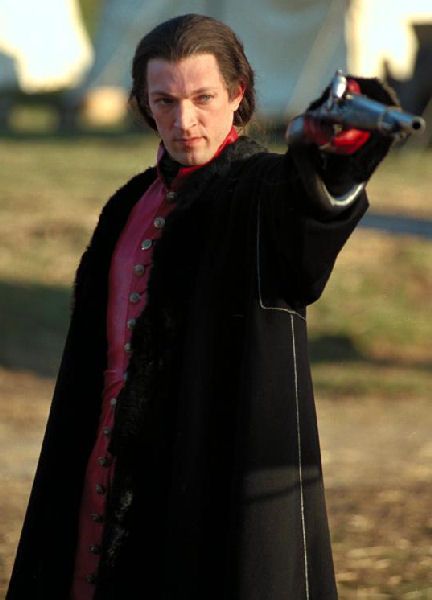When I last wrote on the Beast of Gévaudan, I said that I couldn’t rule out the involvement of one or more human murderers whose actions could have been conflated with several wolves and possibly other wild animals killing French peasants between 1764 – 1767. I meant that literally; the Beast was a craze, and it’s perfectly possible that one or more victims was in fact the victim of a murder. We have no evidence for that, of course, and certainly not for the claim, sometimes made, that the whole thing was the work of a serial killer. This was recently repeated in this otherwise very good video from YouTube channel ‘Storied’ (part two of two; both parts feature the excellent Kaja Franck, who I was fortunate to meet at a conference some years ago). Meagan Navarro of the horror (fiction) website Bloody Disgusting states the following:
“The Beast of Gevaudan or the Werewolf of Dole, these were based on men that were serial killers and slaughtered, and folklore was a means of exploring and understanding those acts by transforming them into literal monsters.”
The ‘werewolf’ of Dole does indeed appear to be a deluded individual who thought he was able to transform into a wolf and was convicted as such. However, this is not the case for Gévaudan, which is a well-documented piece of history, not some post-hoc rationalisation for a series of murders as she implies. The various attacks that comprise the story were widely reported at the time and in some detail (albeit embellishments were added later). No-one at the time suspected an ordinary person of the actual killings, and the only sightings consistently refer to a large beast, sometimes detailing how the kills were made. The idea of a human being in control of the Beast somehow was mooted at the time, as was the werewolf of folklore, but never a straightforward murderer. Of course, the idea of the serial killer was unknown until the late 19th century, and it wasn’t long after this that a specious connection was made. In 1910 French gynaecologist Dr. Paul Puech published the essay (‘La Bête du Gévaudan’, followed in 1911 by another titled ‘Qu’était la bête du Gévaudan?’). Puech’s thin evidence amounted to;
1) The victims being of the same age and gender as those of Jack the Ripper and Joseph Vacher. In fact, women and children (including boys) were not only the more physically vulnerable to attack generally, but were the members of the shepherding families whose job it was to bring the sheep in at the end of the day. This is merely a coincidence.
2) Decapitation and needless mutilation. The latter is pretty subjective, especially if the animal itself might be rabid (plenty were) and therefore attacking beyond the needs of hunger alone. The relevance of decapitation depends upon whether a) this really happened and b) whether a wolf or wolves would be capable of it. Some victims were found to have been decapitated, something that these claimants assert is impossible for a wolf to achieve. I can’t really speak to how plausible this is, although tearing limbs from sizable prey animals is easily done and if more than one animal were involved I’ve little doubt that they could remove a head if they wished. So, did these decapitations actually take place? Jay Smith’s ‘Monsters of the Gévaudan: The Making of a Beast’ relays plenty of reports of heads being ripped off. However, details of these reports themselves mitigate against the idea of a human killer. Take Catherine Valy, whose skull was recovered some time after her death. Captain of dragoons Jean-Baptiste Duhamel noted that “judging by the teeth marks imprinted [on the skull], this animal must have terrifying jaws and a powerful bite, because this woman’s head was split in two in the way a man’s mouth might crack a nut.” Duhamel, like everyone else involved, believed that he faced a large and powerful creature (whether natural or supernatural), not a mere human. Despite the intense attention of the local and national French authorities, not to mention the population at large, no suggestion was ever made nor any evidence ever found of a human murderer and the panic ended in 1767 after several ordinary wolves were shot.
3) Similar deaths in 1765 in the Soissonnais, which he for some reason puts down to a copycat killer rather than, you know, more wolves. This reminds me of the mindset of many true crime writers; come up with your thesis and then go cherry-picking and misrepresenting the data to fit.At the very least then, this claim is speculative, and should not be bandied about as fact (in fact, the YouTube channel should really have queried the claim). So, if not a serial killer, then what? French historian Emmanuel Le Roy Ladurie argues that the Beast was a local legend blown out of proportion to a national level by the rise of print media. Jean-Marc Moriceau reports 181 wolf killings through the 1760s, which puts into context the circa 100 killings over three years in one region of France. That is, statistically remarkable, but within the capability of the country’s wolf population to achieve, especially given the viral and environmental pressures from rabies and the Little Ice Age respectively that Moriceau cites. If we combine these two takes, we get close to the truth, I think. ‘The’ Beast most likely actually consisted of some unusually violent attacks carried out by more than one wolf or packs of wolves that were confabulated and exaggerated as the work of one supernatural beast, before ultimately being pinned by the authorities on several wolves, three shot by François Antoine in 1765 and another supposedly ‘extraordinary’ (yet actually ordinary sized) Jean Chastel in 1767.









